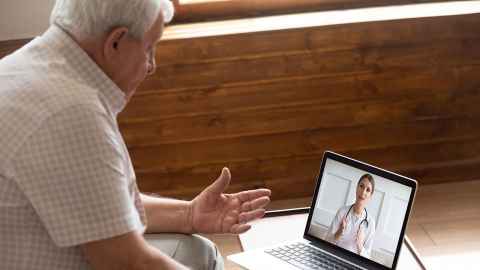Technology that can make people healthier over the internet
13 July 2020
Opinion: Using telehealth technology to care for patients remotely could start to even out inequity in healthcare in rural communities, writes Simon Malpas.

Imagine you live in Ahipara, Northland. You also have early stage heart failure. It’s a 90-minute drive to your nearest hospital in Kerikeri. Your whānau are very much involved in your wellbeing but it’s always a struggle to find one of them who can drive you to the hospital for your three-monthly check-ups.
This scenario is played out daily around Aotearoa and worldwide for many with chronic disease, where equitable access to healthcare is impeded through financial, geographical and logistical barriers. I describe our patient in Ahipara because, statistically, Māori living in Northland have a life expectancy 10 years less than Pākehā.
Tragically, this is a divide that hasn’t changed in 20 years, and as a tertiary institution situated at the University of Auckland we must share some responsibility for this statistic. The solution “starts with us” and presents an opportunity for me and my colleagues at the Auckland Bioengineering Institute to find ways to use our medical technologies to drive change that is focused on addressing healthcare inequity.
Currently, the management of people through their journey of disease is reactive; patients are diagnosed, prescribed a treatment and then followed up on periodically, such as every three to six months, or as symptoms change. Yet pathophysiological changes can occur at irregular intervals. By relying on overt patient symptoms as the driver for intervention, we run the risk of a cascade of pathological events occurring, which could have been avoided.
Consider our patient in Ahipara, and imagine if we could proactively monitor physiological parameters of heart disease in their own home, and alter treatment as needed. We have the technical capability to make this paradigm shift in the management of disease, in a way that could address substantial inequities in access to healthcare, notably in rural communities, and among Māori and Pacific island communities.
The current Covid-19 pandemic has driven a rapid uptake in remote patient consultations using Zoom, Skype and so on and highlighted the potential of telehealth. However, remote consultation can’t provide for physical examination of the patient and nor does it allow for the collection of physiological data.
This is particularly relevant for chronic diseases such as heart failure which follow a trajectory of bouts of hospitalisations as symptoms develop, followed by reactive adjustment of therapy to reduce symptoms, after which the patient is sent home and followed up with periodic consultations. This is the traditional treatment of this chronic disease – we wait for symptoms to develop then adjust treatment. We can do better.
What we need in New Zealand is a focus on developing systems that are whānau-centric to ensure community groups and patients are at the table, in a partnership from the beginning, in the design of the technologies that allow for better and more regular telehealth. We recognise many existing technology solutions based in the community work well in the clinic but often fail in the home. People get frustrated with the technology, fail to see benefit or simply don’t trust doctors.
The challenge we face is in finding ways to measure a patient’s health, interpret that data and then respond, to deliver patient and whānau-centric care.
Research programmes in our Implantable Devices Group at ABI are focused on developing novel implantable sensors for a range of chronic diseases that will enable remote monitoring of people’s condition. For example, one unmet clinical need we are currently addressing is in the area of hydrocephalus. This condition is characterised by an increase in fluid around the brain and is uniformly fatal unless treated.
Neurosurgeons currently treat the condition by placing a small tube in the brain to drain the excess fluid. The problem is that these tubes block, resulting in increased pressure around the brain which causes reduced blood supply to key areas. In children 50 percent of the tubes will have blocked within two years and they will need further invasive surgery to fix the blockage.
We currently have no way of telling when a tube is beginning to block, other than by waiting for symptoms to develop, which is then followed by a CT or MRI scan of the brain. This is classical reactive treatment of a condition.
We are working to improve the lives of people with hydrocephalus by building an ultra-miniature sensor to be placed in the brain alongside the tube that will remotely sense when pressure in the brain is rising.
We have the technical expertise and knowledge that we could apply in clinical applications for a number of diseases. For our person living in Ahipara with heart disease, for instance, we could use such technologies to monitor the pressure in the blood exiting the heart to the lungs, and track heart failure and alter treatment even before symptoms arise.
It is important we find ways such as this to apply our research into new medical technologies to reflect our communities and address healthcare needs, no matter where people live or their socioeconomic status, to prevent hospitalisation and save lives.
Professor Simon Malpas is principal investigator of the Implantable Devices Group at the Auckland Bioengineering Institute.
This article reflects the opinion of the author and not necessarily the views of the University of Auckland.
Used with permission from Newsroom Technology that can make people healthier over the internet 13 July 2020.
Media queries
Alison Sims | Research Communications Editor
DDI 09 923 4953
Mob 021 249 0089
Email alison.sims@auckland.ac.nz